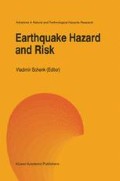Abstract
Estimates of upper bound magnitudes of seismic sources based on historical seismicity are commonly used as scaling parameters in areas that lack identified causative faults. The analysis of the earthquake catalogue of Slovenia and surrounding areas showed that for the region of Slovenia a doubly truncated exponential frequency-magnitude relationship may serve directly for this purpose, taking into account the following assumptions:
(1) The value of the upper bound magnitude, for which the corresponding least-squares estimator of the decay rate has a minimum standard error, is an optimal historical seismicity estimate of the upper bound magnitude.
(2) The difference between the estimated upper bound magnitude and the largest observed magnitude in an area with a well-defined earthquake catalogue is an appropriate increment (typically 0.1 to 0.2) for estimating upper bound magnitudes of seismic sources in the same area with the incremental technique.
There is an indication that such least-squares estimates are similar to or a bit greater than Kijko and Sellevol’s maximum likelihood estimates (1989). Both might be used with reasonable weights as alternatives for upper bound magnitudes in seismic hazard assessment in Slovenia.
Access this chapter
Tax calculation will be finalised at checkout
Purchases are for personal use only
Preview
Unable to display preview. Download preview PDF.
References
Aki, K. (1965) Maximum likelihood estimate of b in the formula log N=a-bM and its confidence limits, Bull. Earthq. Res. Inst. Tokyo Univ. 43, 237–239.
Basham, P. W., D. H. Weichert, and M. J. Berry (1979) Regional assessment of seismic risk in eastern Canada, Bull. Seism. Soc. Am. 69, 1567–1602.
Doser, D. I. and R. B. Smith (1982) Seismic moment rates in the Utah region, Bull. Seism. Soc. Am. 34, 525–551.
Gutenberg, B. and C. F. Richter (1944) Frequency of earthquakes in California, Bull. Seism. Soc. Am. 34, 185–188.
Karnik, V. (1968) Seismicity of the European Area, Part 1, Academia, Czechoslovak Academy of Sciences, Praha.
Kijko, A. and M. A. Sellevoll (1989) Estimation of earthquake hazard parameters from incomplete data files. Part I. Utilization of extreme and complete catalogs with different threshold magnitudes, Bull. Seism. Soc. Am. 79, 645–654.
Krinitzsky E. L. and D. B. Slemmons, Editors (1990) Neotectonics in earthquake evaluation, Reviews in engineering geology VIII, Geol. Soc. Am., Boulder.
Page, R. (1968) Aftershocks and nncroaftershocks of the great Alaska earthquake of 1964, Bull. Seism. Soc. Am. 58. 1131–1168.
Salyards S. L. (1991) A preliminary assessment of the seismic hazard of the southern Rio Grande rift, New Mexico, New Mexico Geological Society Guidebook, 42nd Field Conference, Sierra Blanca, Sacramento, Capitan Ranges.
Schwartz, D. P. and K. J. Coppersmith (1984) Fault behavior and characteristic earthquakes: Examples from the Wasatch and San Andreas fault zones, J. Geophys. Res. 89, 5681–5698.
Slejko, D. and A. Kijko (1991) Seismic hazard assessment for the main seismogenic zones in the Eastern Alps, Tectonophysics 191, 165–183.
Utsu, T. (1966) A statistical significance test of the difference in b-value between two earthquake groups, J. Phys. Earth 14, 37–40.
Weichert, D. H. (1980) Estimation of the earthquake recurrence parameters for unequal observation periods for different magnitudes, Bull. Seism. Soc. Am. 70, 1337–1346.
Wells, D. L. and K. J. Coppersmith (1994) New Empirical Relationships among Magnitude, Rupture Length, Rupture Width, Rupture Area, and Surface Displacement, Bull. Seism. Soc. Am., 84, 974–1002.
Wesnousky, S. G. (1986) Earthquakes, quaternary faults, and seismic hazard in California, J. Geophys. Res. 91, 12587–12631.
Youngs, R. R. and K. J. Coppersmith (1985) Implications of fault slip rates and earthquake recurrence models to probabilistic seismic hazard estimates, Bull. Seism. Soc. Am. 75, 939–964.
Živčić, M. (1992) Earthquake catalogue for Probabilistic assessment for seismic hazard at Krško Nuclear Power Plant. Report of the Institute of Structural and Earthquake Engineering, Department of Civil Engineering, University of Ljubljana, 92 pages.
Author information
Authors and Affiliations
Editor information
Editors and Affiliations
Rights and permissions
Copyright information
© 1996 Kluwer Academic Publishers
About this chapter
Cite this chapter
Lapajne, J.K., Motnikar, B.Š. (1996). Estimation of Upper Bound Magnitude in Earthquake Hazard Assessment in Slovenia. In: Schenk, V. (eds) Earthquake Hazard and Risk. Advances in Natural and Technological Hazards Research, vol 6. Springer, Dordrecht. https://doi.org/10.1007/978-94-009-0243-5_4
Download citation
DOI: https://doi.org/10.1007/978-94-009-0243-5_4
Publisher Name: Springer, Dordrecht
Print ISBN: 978-94-010-6592-4
Online ISBN: 978-94-009-0243-5
eBook Packages: Springer Book Archive

